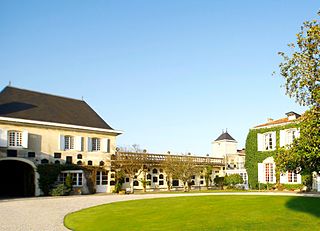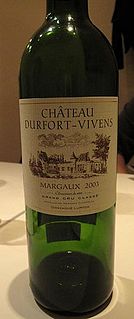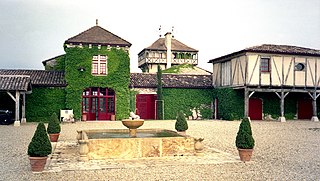
The Bordeaux Wine Official Classification of 1855 resulted from the 1855 Exposition Universelle de Paris, when Emperor Napoleon III requested a classification system for France's best Bordeaux wines that were to be on display for visitors from around the world. Brokers from the wine industry ranked the wines according to a château's reputation and trading price, which at that time was directly related to quality.

Château Margaux, archaically La Mothe de Margaux, is a wine estate of Bordeaux wine, and was one of four wines to achieve Premier cru status in the Bordeaux Classification of 1855. The estate's best wines are very expensive, with a standard-sized bottle of the Château Margaux grand vin retailing at an average price of $639. The estate is located in the commune of Margaux on the left bank of the Garonne estuary in the Médoc region, in the département of Gironde, and the wine is delimited to the AOC of Margaux.
Margaux is a wine growing commune and Appellation d'origine contrôlée within Haut-Médoc in Bordeaux, centred on the village of Margaux. Its leading château is also called Margaux. It contains 21 cru classé châteaux, more than any other commune in Bordeaux.

Château Prieuré-Lichine, previously Château Le Prieuré and Château Prieuré-Cantenac, is a winery in the Margaux appellation of the Bordeaux region of France, in the commune of Cantenac. The wine produced here was classified as one of ten Quatrièmes Crus in the historic Bordeaux Wine Official Classification of 1855.

Château Rauzan-Gassies is a winery in the Margaux appellation of the Bordeaux region of France. Château Rauzan-Gassies is also the name of the red wine produced by this property. The wine produced here was classified as one of fifteen Deuxièmes Crus in the original Bordeaux Wine Official Classification of 1855.
Château Brane-Cantenac is a winery in the Margaux appellation of the Bordeaux wine region of France. The wine produced here was classified as one of fifteen Deuxièmes Crus in the original Bordeaux Wine Official Classification of 1855.

Château Durfort-Vivens is a winery in the Margaux appellation of the Bordeaux region of France. It is also the name of the red wine produced by this property. The wine produced here was classified as one of fifteen Deuxièmes Crus in the original Bordeaux Wine Official Classification of 1855.

Château Palmer is a winery in the Margaux appellation d'origine contrôlée of the Bordeaux region of France. The wine produced here was classified as one of fourteen Troisièmes Crus in the historic Bordeaux Wine Official Classification of 1855. The property is situated in the communes Margaux and Cantenac, and its wine is considered to be one of the two most popular Third Growths.
Château Ferrière is a winery in the Margaux appellation of the Bordeaux region of France. The wine produced here was classified as one of fourteen Troisièmes Crus in the historic Bordeaux Wine Official Classification of 1855. The Château has 29 acres (12 ha) planted with Cabernet Sauvignon, Merlot and Cabernet Franc.

Château Dauzac is a winery in the Margaux appellation of the Bordeaux region of France, in the commune of Labarde. The wine produced here was classified as one of eighteen Cinquièmes Crus in the Bordeaux Wine Official Classification of 1855. Since 1988, the estate has belonged to the insurance company MAIF, but is managed by the André Lurton group. In 2004, his daughter Christine Lurton-Bazin de Caix took charge of the property.
Château Chasse-Spleen is a winery in the Moulis-en-Médoc appellation of the Bordeaux region of France, just north-west of Margaux. Château Chasse-Spleen was selected as one of six Crus Exceptionnels in the Cru Bourgeois classification of 1932, and through later revisions until the annulment of the classification in 2007. The estate is today widely considered to be of cru classé standard.

Château Gloria is an unclassed Bordeaux wine from the Saint-Julien appellation. The winery is located in the central part of France’s Bordeaux wine region Haut-Médoc, in the commune of Saint-Julien-Beychevelle.

Château Smith Haut Lafitte is a Bordeaux wine from the Pessac-Léognan appellation, ranked among the Crus Classés for red wine in the Classification of Graves wine of 1953 and 1959. The winery and vineyards are located south of the city of Bordeaux, in the commune of Martillac.
Vieux Château Certan is a Bordeaux wine from the appellation Pomerol. The winery is located on the Right Bank of the Bordeaux wine region, in the commune of Pomerol in the department Gironde. As all wine produced in this appellation, Vieux Château Certan is unclassified, but the estate is long recognised as among the great growths of the region, and by some reckoned comparable to neighbouring estate Château Pétrus.
Château Petit-Village is a Bordeaux wine from the appellation Pomerol. The winery is located on the Right Bank of the Bordeaux wine region, in the commune of Pomerol in the department Gironde. As all wine produced in this appellation, Château Petit-Village is unclassified, but the estate is estimated among the great growths of the region.
Château d'Angludet or Château Angludet, is a Bordeaux wine estate in the appellation Margaux, in the commune of Cantenac on the left bank of the Gironde. The estate was classified a Cru Bourgeois Exceptionnel in 1932, and most recently a Cru Bourgeois Supérieur in 2003, in a classification which has been inactive since 2007.
Château Olivier is a Bordeaux wine from the Pessac-Léognan appellation, ranked among the Crus Classés de Graves for red and dry white wine in the Classification of Graves wine of 1953 and 1959. The winery and vineyards are located south of the city of Bordeaux, in the commune of Léognan.
Château La Tour de Mons, archaically named Tour de Marsac, is a winery and wine from the appellation Margaux, located in the Left Bank of the Bordeaux wine region of France, in the commune of Soussans. The wine was rated Cru Supérieur in the Cru Bourgeois classification of 1932, and through later revisions until the temporary annulment of the classification in 2007.
Château Rauzan-Ségla, or Château Rausan-Ségla, is a winery in the Margaux appellation of the Bordeaux region of France. Château Rauzan-Ségla is also the name of the red wine produced by this property. The wine produced here was classified as one of fifteen Deuxièmes Crus in the original Bordeaux Wine Official Classification of 1855. The alternate name "Rausan-Ségla" was also frequently used until 1994 when the original "Rauzan-Ségla" again became the official name.














